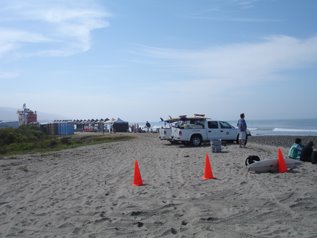
Dingo is shown here fishing with one of the DogPatch Locals (in the hat) hoping to catch a CATFISH!
(and yes, they did use the little blue baggies to pick up after themselves)




 Tue Jun 27, 10:57 AM ET
Tue Jun 27, 10:57 AM ET
Australian researchers say they have discovered a new repellent that can help with everything from rehabilitating old mine sites to reducing the amount of roadkill. It's dingo urine.
Researchers at Curtin University have been startled by the effectiveness of urine from Australia's wild dogs in scaring off kangaroos which chew through areas of new-growth vegetation.
The university's Michael Parsons said the discovery could have important applications in helping to re-establish plant life on old mine sites by repelling kangaroos, unique Australian marsupials which number in the tens of millions.
Researchers looked at the effectiveness of chemicals found in the urine of dingoes and non-native predators like coyotes.
"When we presented tame kangaroos with coyote urine, they became interested in the new smell, but when presented with the dingo urine they were startled and fled," Parsons said.
He told Reuters Tuesday that the effect of urine on wild kangaroos was even more dramatic.
Parsons's team is looking at ways of delivering the repellent effectively at mine sites and how much would be needed, as well as whether it could be used to reduce the number of collisions between kangaroos and vehicles on outback roads.
He said the university was also trying to isolate and synthesize the active chemicals in dingo urine so that it could be made in quantities large enough to be commercially viable.
For now, the university is receiving supplies of the real thing from Australia's Dingo Conservation Society, but he said how it is gathered is a tightly held secret.
"At one stage we fashioned a little urine catcher to walk dingoes and collect it from, but that tended to be risky," Parsons said.
 A diagram showing how the Sun moves through the sky on the Summer solstice. |
The upper panel shows that on the summer solstice (which occurs around June 21), the northern half of the Earth is tilted towards the Sun. Notice that the Sun is north of the equator. For you in Topeka, the altitude of the Sun at noon is 73.5°, which is pretty high in the sky. In fact, that is as high as the Sun ever gets at that latitude. It has been getting higher and higher in the sky since the winter solstice and through the vernal equinox. The bottom panel shows how the Sun moves through the sky for someone standing on the ground in Topeka.
So in general, the northern hemisphere is getting more direct sunlight, which heats the Earth most efficiently, than the southern hemisphere. This is summer for people in the northern hemisphere. During the summer, the Sun is also above the horizon longer than it is during the winter. The summer solstice is the longest day of the year.
At this same time, the southern half of the Earth is tilted away from the Sun. If you were living in Neuquen, Argentina (roughly -40° S latitude) you would be bundled up for the winter.
How high the Sun gets in your sky, and how long it is above the horizon during the day, depend not only on the season, but also on your latitude. San Clemente (UPI) The Pillsbury Dough Boy is alive. He was photographed by an operative of The blog monitor while attempting to flee the photographer this Sunday at San Onofre Surf Beach. There is a rumor that he entered the Federal Witness Protection Program for unknown reasons. Official sources won't comment. It is suspected that an imposter was involved in the faking of his death and quickie funeral.
San Clemente (UPI) The Pillsbury Dough Boy is alive. He was photographed by an operative of The blog monitor while attempting to flee the photographer this Sunday at San Onofre Surf Beach. There is a rumor that he entered the Federal Witness Protection Program for unknown reasons. Official sources won't comment. It is suspected that an imposter was involved in the faking of his death and quickie funeral.
 Dingo has been arrested and is being held under armed guard at Camp Pendleton. Rumors at the military base say that the arrest is related to the death of the Pillsbury Dough Boy. Nothing is known as to the charges because the arrest was made under a sealed warrant by Homeland Security, who have since handed Dingo over to the USMC Military Police.
Dingo has been arrested and is being held under armed guard at Camp Pendleton. Rumors at the military base say that the arrest is related to the death of the Pillsbury Dough Boy. Nothing is known as to the charges because the arrest was made under a sealed warrant by Homeland Security, who have since handed Dingo over to the USMC Military Police. Rancho Sante Fe, CA (UPI) Veteran Pillsbury spokesman, the Pillsbury Dough Boy, died yesterday of a yeast infection and complications from repeated pokes in the belly, most recently when brought in for questioning by police in San Clemente, California. He was 76.
Rancho Sante Fe, CA (UPI) Veteran Pillsbury spokesman, the Pillsbury Dough Boy, died yesterday of a yeast infection and complications from repeated pokes in the belly, most recently when brought in for questioning by police in San Clemente, California. He was 76.

